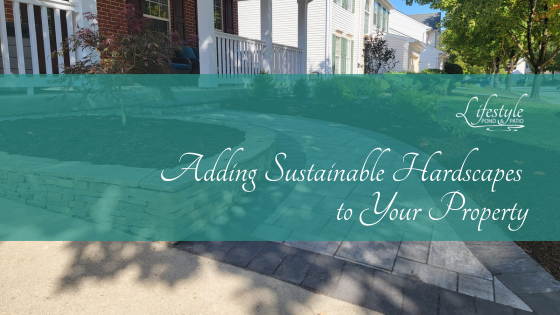
When it comes to sustainable landscaping, the incorporation of hardscapes is an aspect that’s often overlooked. Hardscapes—like walkways, walls, outdoor kitchens, and patios—are not just add-ons; they can profoundly enhance your property’s functionality and aesthetic appeal. The key, however, lies in integrating these features in an environmentally conscious manner.
- Permeable Materials
- Opt for permeable paving materials when designing walkways and patios. These innovative materials are pivotal in allowing water to seep through the surface, significantly reducing runoff and aiding in groundwater replenishment—an essential aspect in areas near delicate ecosystems like the Chesapeake Bay.
- Strategic Placement
- Thoughtfully design your hardscape to complement the natural contours of your landscape. For instance, situating a patio in a naturally flat area of your yard can minimize the need for extensive land alteration and grading, preserving the natural lay of the land.
- Local and Recycled Materials
- Choose materials that are either locally sourced or recycled. This approach reduces the environmental impact associated with transportation, supports local businesses, and promotes the recycling industry.
- Dual-Purpose Features
- Embrace hardscapes that offer multiple uses. For example, a creatively designed retaining wall can provide structural support while doubling as an informal seating area. Similarly, vertical walls can be adorned with greenery, enhancing aesthetic appeal and biodiversity.
- Eco-friendly Maintenance
- Select materials that are low-maintenance and don’t require harmful chemicals for upkeep. This ensures minimal chemical runoff into our water systems, safeguarding the local aquatic life.
- Shade and Windbreaks
- Utilize hardscape structures to create natural shade or windbreaks around your home. This enhances comfort and can lead to reduced energy consumption by moderating temperatures naturally.
- Wildlife Consideration
- Design your hardscape with local wildlife in mind. Avoid materials and layouts that could disrupt the natural movement of fauna, ensuring your property remains a haven for local biodiversity.
Incorporating sustainable hardscapes into your property is more than just an aesthetic upgrade—it’s a commitment to environmental responsibility and stewardship. By embracing these eco-friendly practices, you enhance the beauty and functionality of your outdoor space while actively contributing to preserving our water bodies. Let’s create sustainable areas that are not only visually stunning but also ecologically sound.
Ready to transform your outdoor space with sustainable hardscapes? Together, we can build a beautiful, sustainable future, one property at a time.
